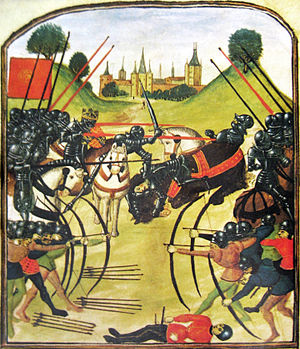Battle of Tewkesbury
| Battle of Tewkesbury | |||||||
|---|---|---|---|---|---|---|---|
| Part of the Wars of the Roses | |||||||
 The battle of Tewkesbury, depicted in a Ghent manuscript |
|||||||
|
|||||||
| Belligerents | |||||||
|
|
|
||||||
| Commanders and leaders | |||||||
|
|
John Beaufort, Marquess of Dorset † John, Lord Wenlock † |
||||||
| Strength | |||||||
| 3,500-5,000 | 6,000 | ||||||
| Casualties and losses | |||||||
| Unknown | 2,000 | ||||||
The Battle of Tewkesbury, which took place on 4 May 1471, was one of the decisive battles of the Wars of the Roses. The forces loyal to the House of Lancaster were completely defeated by those of the rival House of York under their monarch, King Edward IV. The Lancastrian heir to the throne, Edward, Prince of Wales, and many prominent Lancastrian nobles were killed during the battle or were dragged from sanctuary two days later and immediately executed. The Lancastrian king, Henry VI, who was a prisoner in the Tower of London, died or was murdered shortly after the battle. Tewkesbury restored political stability to England until the death of Edward IV in 1483.
The term, the Wars of the Roses, refers to the informal heraldic badges of the two rival houses of Lancaster and York which had been contending for power, and ultimately for the throne, since the late 1450s. In 1461 the Yorkist claimant, Edward, Earl of March, was proclaimed King Edward IV and defeated the supporters of the weak, intermittently insane Lancastrian king Henry VI at the Battle of Towton. Lancastrian revolts in the far north of England were defeated in 1464, and the fugitive King Henry was captured and imprisoned the next year. His Queen, Margaret of Anjou, and their thirteen-year-old son Edward of Westminster, were exiled and impoverished in France. Edward IV's hold on the throne appeared temporarily to be secure.
Edward IV owed his victory in large measure to the support of his cousin, the powerful Earl of Warwick. They became estranged when Edward spurned the French diplomatic marriage that Warwick was seeking for him and instead married Elizabeth Woodville, widow of an obscure Lancastrian gentleman, in secret in 1464. When the marriage became public knowledge, Edward placed many of his new queen's family in powerful positions that Warwick had hoped to control. Edward meanwhile reversed Warwick's policy of friendship with France by marrying his sister Margaret to Charles the Bold, the Duke of Burgundy. The embittered Warwick secured the support of Edward IV's brother George, Duke of Clarence, for a coup, in exchange for Warwick's promise to crown Clarence king. Although Edward was imprisoned briefly, Clarence was unacceptable as monarch to most of the country. Edward was allowed to resume his rule, outwardly reconciled with Warwick and Clarence. Within a year, he accused them of fresh treachery and forced them to flee to France.
...
Wikipedia
